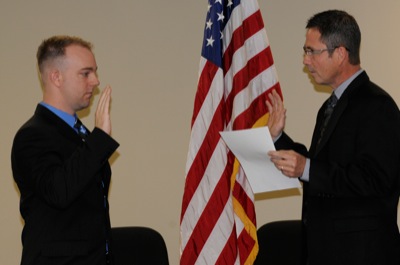Thursday, October 31st, 2013
Celina trims $6 million from debt in two years
By William Kincaid
CELINA - Mayor Jeff Hazel said $6 million has been shaved from the city's total debt the last two years.
He's hoping to reduce Celina's financial obligation - estimated at $17.27 million as of Jan. 1, 2014 - further in the coming years. Hazel informed council members of the reduction at Monday's council meeting.
"By the end of the first term, we're thinking that we'll be able to cut that (debt) down to about $13 million, so we should be able to peel off $10 million of debt and liability over these four years," Hazel later told the newspaper.
Reducing the city's financial burden was a major goal when he took office, he said. The days of routinely relying on borrowed money to finance projects are over, Hazel and safety service director Tom Hitchcock said.
"You'll see the numbers continue to decrease each year but it won't be $6 million every two years," Hitchcock added. "I think our next two years will be $4 million."
In addition to making its required annual payments on principal and interest - accumulated over the years mostly for infrastructure projects - the city will refrain from taking on more debt unless deemed absolutely necessarily, according to the two men.
"It's got to be really something big for us to feel like it's going to benefit the entire community for us to do something," Hazel said about taking on more debt.
Municipal debt is a valuable tool to launch major projects if used responsibly, but it wouldn't be practical or possible to pay for everything in cash, he said.
"We've got improvements from it. I'm not criticizing it .. but that stays on the books," Hazel said.
The ongoing $1.34 million East Market Street project will be paid without additional debt. The city utilized a $350,000 grant from the Ohio Public Works Commission, roughly $90,000 in state Community Development Block Grant funds and revenue from a Tax Increment Financing incentive district. Also used was additional revenue from the storm water capital account and the newly created waterline replacement account established with general fund carryover.
It's not fiscally responsible to take out a 20-year note for a project that has a lifespan of 12 to 15 years, Hazel noted. But if it's a long-term initiative - such as a massive water system upgrade that serves the community for 50 years - then it's reasonable, he said.
Last year, city officials rolled out a long-term street improvement project that includes reconstructing and/or repaving select roads based on priority and the condition of underground utility lines.
"But if we went out and got a $50 million note to do all of those in the next couple of years, we're going to be done, we won't be able to do anything else because everything would be tied up in making those payments," Hazel said.
In the spring, city council members approved paying the remaining debt - $937,553.26 - on the Main Street reconstruction project, which was completed in 2011. In 2012, Mercer County used inactive funds to refinance $926,000 of the debt for one year. The city paid the principal and $11,553.26 in interest. The loan marked the first time county officials invested in municipal debt with Celina.
City officials had sought refinancing bids from local banks for the Main Street project but the county offered the lowest interest rate at 1.1 percent.
Council members also decided to pay off the $150,958 debt on the city's industrial park six years early. The action saved $39,290 in interest costs.
Much of the city's remaining debt is noncallable, meaning the city wouldn't save any money by paying it off early, Hazel said.



